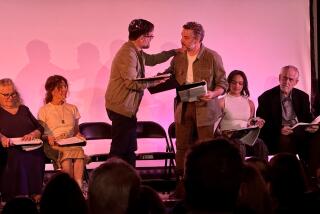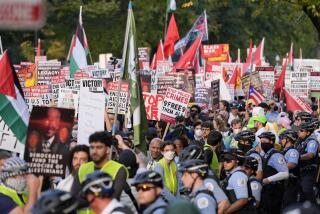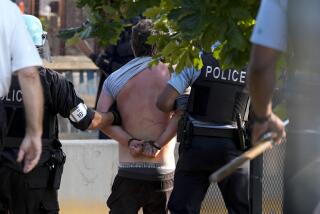Protest and live theater converge on 7th Avenue
NEW YORK â No place in America, or possibly anywhere, is more theatrical than New York. And for a great many New Yorkers, there is no better entertainment to be found than in performing for one another and watching one another. Everyone -- whether the uppity Upper East doorman or the tattooed, pierced kid in the East Village -- has a role to play and relishes playing it.
Thus it proved that the huge protest march Sunday afternoon, estimated by some organizers as half a million strong, was one epic piece of street theater. That, anyway, was the way newspaper and television reports described it. A skeptical CNN anchor went so far as to wonder whether protesters of the Republican National Convention could continue to put on a good enough show to keep anyone, and the protesters in particular, interested all week.
Sundayâs demonstration had its obvious theatrical elements -- the costumes, the role-playing, the evident desire of many involved to put on a good show. The police were said to have rehearsed their parts for a year. Some protesters came well-prepared also. A group of clowns sported the message âMission Accomplicatedâ on the backs of their goofy fatigues. âPallbearersâ bore flag-draped cardboard coffins, 1,000 of them, according to organizers, somberly symbolizing Americans killed in Iraq.
What with coffins and clowns, the laughter and the tears, even (thank you, clowns) the greasepaint, one would be hard put not to call such spectacle theater. But are such rallies really theater, and if so, what kind? I went Sunday to find out. Specifically I hoped to be an audience member, a spectator. It proved difficult.
The crowd for the first half of the march up 7th Avenue was an enormous crush. The afternoon was hot, humid, gridlocked. There were no sidelines. As the march gradually approached the convention site, Madison Square Garden, the real show began. It was here, after spending a couple of hours trying to walk a few blocks, that emotions among demonstrators reached their highest pitch in the chanting, venting, whooping, singing, dancing, whatever. The viewing stands were for officials and television. The march did then proceed, to where it was possible to watch from the sidewalks, but by then the heat and humidity had taken their withering toll.
So what one experienced in the midst was not the show but one tiny bit of it, small vignettes within the sea of humanity that extended a mile ahead and a mile behind. These could be touching (cranky, elderly mathematicians with their painted signs on their baseball caps) and comforting (a bemused cop with a heavy New York accent volunteering helpful advice and cute wisecracks). No one around me was in the least bit threatening, neither demonstrators nor cops, although I later read of a few incidents and arrests.
But as much as one might feel in the midst of live theater, it really wasnât. The audience was the media, which pretended not to be part of the goings-on but, in fact, continually influenced the action in small ways as well as large ones. As my particular group reached Madison Square Garden, drummers and dancers formed a circle and began performing. Several cameramen jumped into the middle of it to get pictures, entirely changing the dynamic.
âSixty Camerasâ
The question of how so multifaceted an event as a really large demonstration can be witnessed is, in the end, a question for artists.
Later Sunday evening, in a small movie theater operated by a pizza parlor in the East Village, a film, âSixty Cameras Against the War,â attempted to answer that question. The film is a collage of 60 films of the antiwar rally in Manhattan on Feb. 15, 2003. The âfilmsâ are made by witnesses with camcorders, and the experimental documentary cuts from one clip to the next, often showing three at once. With so many points of view, no single one should be able to prevail.
Yet this angry, polemical film is claustrophobic. Unlike Sundayâs peaceful turnout, the earlier rally was violent. Most of the footage documents confusion, marchers being penned in and taking part in skirmishes with police. The 60 cameras, often showing the same thing from different angles, are used as material witnesses for the defense of the demonstrators. Instead of offering a sense of perspective on what was undoubtedly a complex and unstable situation, the film shows the same thing times 60.
Being at Sundayâs demonstration, I have but a small, limited idea of what went on. Watching âSixty Cameras,â I also have a small, limited idea of what went on at the rally last year. What we need now is for artists to turn this raw material into real, absorbable theater.
More to Read
The biggest entertainment stories
Get our big stories about Hollywood, film, television, music, arts, culture and more right in your inbox as soon as they publish.
You may occasionally receive promotional content from the Los Angeles Times.











